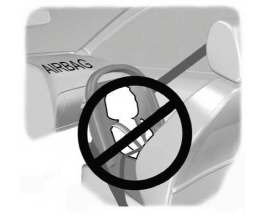Lincoln Aviator: Changing a Road Wheel / Tire Change Procedure
WARNING: The jack supplied with this vehicle is only intended for changing wheels. Do not use the vehicle jack other than when you are changing a wheel in an emergency.
WARNING: Check that the vehicle jack is not damaged or deformed and the thread is lubricated and clean.
WARNING: When one of the front wheels is off the ground, the transmission alone will not prevent the vehicle from moving or slipping off the jack, even if the transmission is in park (P).
WARNING: To help prevent your vehicle from moving when changing a wheel, shift the transmission into park (P), set the parking brake and use an appropriate block or wheel chock to secure the wheel diagonally opposite to the wheel being changed. For example, when changing the front left wheel, place an appropriate block or wheel chock on the right rear wheel.
WARNING: Always use the jack provided as original equipment with your vehicle. If using a jack other than the one provided, make sure the jack capacity is adequate for the vehicle weight, including any vehicle cargo or modifications. If you are unsure if the jack capacity is adequate, contact the authorized dealer.
WARNING: Failure to follow these guidelines could result in an increased risk of loss of vehicle control, injury or death.
WARNING: Use only the specified jacking points. If you use other positions, you may damage the body, steering, suspension, engine, braking system or the fuel lines.
WARNING: Do not work on your vehicle when the jack is the only support. If the vehicle slips off the jack, you or someone else could be seriously injured.
WARNING: Never place anything between the vehicle jack and your vehicle.
WARNING: Never place anything between the vehicle jack and the ground.
WARNING: Park your vehicle so that you do not obstruct the flow of traffic or place yourself in any danger and set up a warning triangle.
WARNING: Do not attempt to change a tire on the side of the vehicle close to moving traffic. Pull far enough off the road to avoid the danger of being hit when operating the jack or changing the wheel.
Note: Passengers should not remain in your vehicle when the vehicle is being jacked.
Note: Jack at the specified locations to avoid damage to the vehicle.
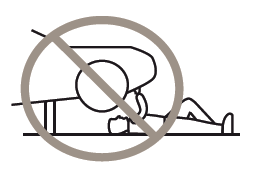
Note: No maintenance or additional lubrication of your jack is required over the service life of your vehicle.
- Park on a level surface, set the parking brake and switch on the hazard flashers.
- Apply the parking brake, place the transmission in park (P) and turn the engine off.
- If your vehicle has air suspension, use
the touch screen to switch on the Air
Suspension Service Mode prior to
jacking.
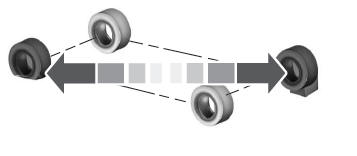
- Block the wheel diagonally opposite the
flat tire. For example, if the left front tire
is flat, block the right rear wheel.
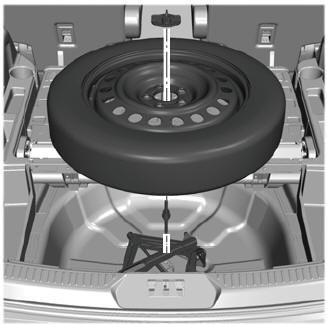
- Turn the wing nut securing the spare tire counterclockwise, remove the wing nut.
- Remove the spare tire, jack and wrench
from the spare tire storage compartment
under the trunk load floor.
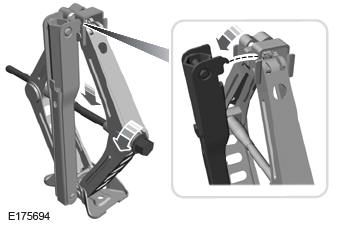
- Turn the hex nut on the jack
counterclockwise to remove the lug
wrench from jack. This lowers the jack
and loosens the mechanical lock.
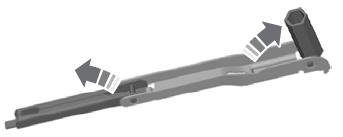
- Unfold the wrench for use.
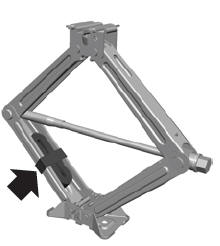
- Remove the strap from the jack.
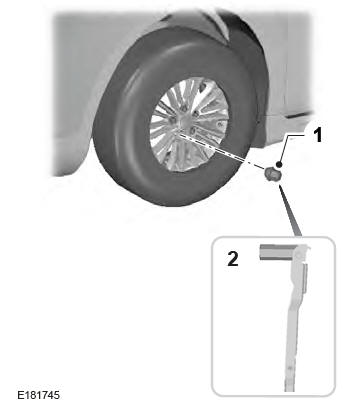
- Loosen each wheel lug nut one-half
turn counterclockwise, but do not
remove them until the flat tire is raised
off the ground.
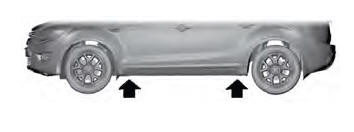
- Find the jacking points shown here,
small arrow-shaped marks on the sills
show the location of the jacking points.
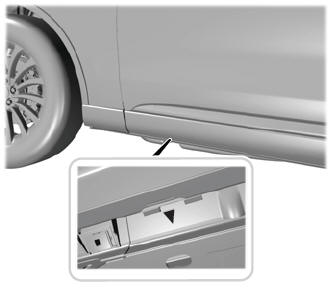
- If your vehicle is equipped with running
boards the jacking points will be
marked on the front and rear of the
running board.
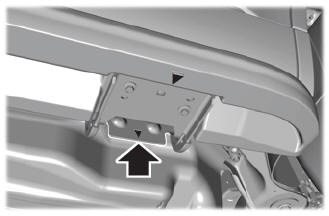
- Place the jack at the jacking point next
to the tire which you are changing. Turn
the lug wrench handle clockwise until
the flat tire is completely off the ground.
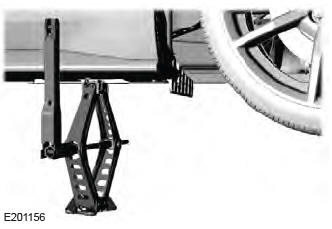
- Remove the lug nuts with the lug wrench.
- Replace the flat tire with the spare tire, making sure the valve stem is facing outward.
- Install the lug nuts snug against the hub. Do not fully tighten the lug nuts until the vehicle is lowered.
- Turn the wrench handle
counterclockwise to lower the vehicle
completely.
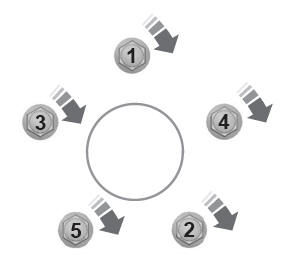
- Remove the jack and fully tighten the lug nuts in the order shown.
- If you enabled the Air Suspension Service Mode, switch the mode off prior to driving.
- Remove the wheel blocks.
Stowing the jack
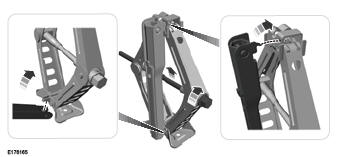
- To store the folded wrench on the jack, engage the bracket of the jack base and the lug wrench pin, swing the wrench upwards, adjust jack height until the wrench hook engages the hole on jack. Tighten the hex nut clockwise by hand until secure.
- Place the jack in the spare tire compartment, install the wing nut and tighten clockwise by hand until secure.
Stowing the flat tire
You cannot store the full-sized road wheel in the temporary spare tire well.
- Find the flat tire retainer strap tucked inside the jack channel. Lower the carpeted load floor.
- Stow the flat tire in the cargo area on the
load floor with the wheel facing up.
Secure the flat tire with the retainer strap
by following the next steps.
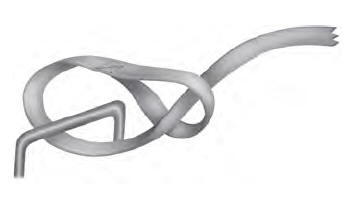
- Locate the rear left side and right side cargo tie-down rings. Push the loop end of the retainer strap through one cargo tie-down ring. Thread the non-loop end through the loop.
- Weave the retainer strap through the
wheel openings.
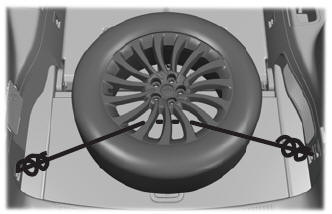
- Locate the front cargo tie-down in the
opposite rear corner of the cargo area.
Thread the retainer strap through the
tie-down and pull tight.

- Secure by tying a 2-half hitch knot.
 Dissimilar Spare Wheel and Tire Assembly Information
Dissimilar Spare Wheel and Tire Assembly Information
WARNING: Failure to follow these
guidelines could result in an increased risk
of loss of vehicle control, injury or death.
If you have a dissimilar spare wheel and tire,
then it is intended for temporary use only...
 Technical Specifications
Technical Specifications
Wheel Lug Nut Torque Specifications
WARNING: When you install a wheel, always remove any corrosion, dirt or
foreign materials present on the mounting surfaces of the
wheel or the surface of the wheel hub, brake drum or brake disc that contacts
the wheel...
Other information:
Lincoln Aviator 2020-2025 Owners Manual: Washer Fluid Check. Fuel Filter. Checking the Wiper Blades
Washer Fluid Check WARNING: If you operate your vehicle in temperatures below 41.0°F (5°C), use washer fluid with antifreeze protection. Failure to use washer fluid with antifreeze protection in cold weather could result in impaired windshield vision and increase the risk of injury or accident...
Lincoln Aviator 2020-2025 Service Manual: Description and Operation - Second Row Climate Control - Overview
Overview The second row climate control system has components located in the center lower section of the climate control housing and floor console. The temperature and controls breakdown for the HVAC system is as follows, the first row driver, first row passenger, second row seating temperature and third row seating temperature...
Categories
- Manuals Home
- Lincoln Aviator Owners Manual
- Lincoln Aviator Service Manual
- Body and Paint
- USB Port and Power Point Locations
- Child Safety Locks
- New on site
- Most important about car
Children and Airbags
WARNING: Airbags can kill or injure a child in a child restraint. Never place a rear-facing child restraint in front of an active airbag. If you must use a forward-facing child restraint in the front seat, move the seat upon which the child restraint is installed all the way back.
